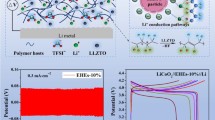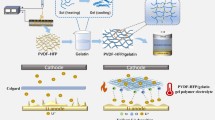Abstract
Lithium (Li) metal is one of the most promising anodes for next-generation energy storage systems. However, the Li dendrite formation and unstable solid-electrolyte interface (SEI) have hindered its further application. Lithium nitrate (LiNO3) is extensively used as an effective electrolyte additive in ether-based electrolytes to improve the stability of lithium metal. Nevertheless, it is rarely utilized in carbonate electrolytes due to its low solubility. Here, a novel gel polymer electrolyte (GPE) consisting of poly(vinylidene fluoride) (PVDF), poly(methyl methacrylate) (PMMA), poly(ethylene oxide) (PEO) with LiNO3 additive is proposed to solve this issue. In this GPE, polyether-based PEO serves as a matrix for dissolving LiNO3 which can be decomposed into a fast Li-ion conductor (Li3N) in conventional carbonate electrolytes to enhance the stability and Li+ conductivity of the SEI film. As a result, dendrite formation is effectively suppressed, and a significantly improved average Coulombic efficiency (CE) of 97.2% in Li-Cu cell is achieved. By using this novel GPE coupled with Li anode and LiNi0.5Mn0.3Co0.2O2 (NMC532), excellent capacity retention of 94.1% and high average CE of over 99.2% are obtained after 200 cycles at 0.5 C. This work presents fresh insight into practical modification strategies on high-voltage Li metal batteries.

Similar content being viewed by others
References
Lu, J.; Chen, Z. W.; Pan, F.; Cui, Y.; Amine, K. High-performance anode materials for rechargeable lithium-ion batteries. Electrochem. Energy Rev.2018, 1, 35–53.
Tarascon, J. M.; Armand, M. Issues and challenges facing rechargeable lithium batteries. Nature2001, 414, 359–367.
Du, H. R.; Huang, K. F.; Li, M.; Xia, Y. Y.; Sun, Y. X.; Yu, M. K.; Geng, B. Y. Gas template-assisted spray pyrolysis: A facile strategy to produce porous hollow Co3O4 with tunable porosity for high-performance lithium-ion battery anode materials. Nano Res.2018, 11, 1490–1499.
Liu, T. C.; Lin, L. P.; Bi, X. X.; Tian, L. L.; Yang, K.; Liu, J. J.; Li, M. F.; Chen, Z. H.; Lu, J.; Amine, K. et al. In situ quantification of interphasial chemistry in Li-ion battery. Nat. Nanotechnol.2019, 14, 50–56.
Xiang, J. W.; Yang, L. Y.; Yuan, L. X.; Yuan, K.; Zhang, Y.; Huang, Y. Y.; Lin, J.; Pan, F.; Huang, Y. H. Alkali-metal anodes: From lab to market. Joule2019, 3, 2334–2363.
Yin, Y. X.; Xin, S.; Guo, Y. G.; Wan, L. J. Lithium-sulfur batteries: Electrochemistry, materials, and prospects. Angew. Chem., Int. Ed.2013, 52, 13186–13200.
Liu, H.; Liu, M. Q.; Yang, L. Y.; Song, Y. L.; Wang, X. B.; Yang, K.; Pan, F. A bi-functional redox mediator promoting the ORR and OER in non-aqueous Li-O2 batteries. Chem. Commun.2019, 55, 6567–6570.
Jiang, Z. P.; Jin, L.; Han, Z. L.; Hu, W.; Zeng, Z. Q.; Sun, Y. L.; Xie, J. Facile generation of polymer-alloy hybrid layers for dendrite-free lithium-metal anodes with improved moisture stability. Angew. Chem., Int. Ed.2019, 58, 11374–11378.
Wang, M. Q.; Peng, Z.; Luo, W. W.; Ren, F. H.; Li, Z. D.; Zhang, Q.; He, H. Y.; Ouyang, C. Y.; Wang, D. Y. Tailoring lithium deposition via an SEI-functionalized membrane derived from LiF decorated layered carbon structure. Adv. Energy Mater.2019, 9, 1802912.
Huang, Z. J.; Zhou, G. M.; Lv, W.; Deng, Y. Q.; Zhang, Y. B.; Zhang, C.; Kang, F. Y.; Yang, Q. H. Seeding lithium seeds towards uniform lithium deposition for stable lithium metal anodes. Nano Energy2019, 61, 47–53.
Kim, J. Y.; Liu, G. C.; Tran, M. X.; Ardhi, R. E. A.; Kim, H.; Lee, J. K. Synthesis and characterization of a hierarchically structured three-dimensional conducting scaffold for highly stable Li metal anodes. J. Mater. Chem. A2019, 7, 12882–12892.
Song, H. Y.; Chen, X. L.; Zheng, G. L.; Yu, X. J.; Jiang, S. F.; Cui, Z. M.; Du, L.; Liao, S. J. Dendrite-free composite Li anode assisted by ag nanoparticles in a wood-derived carbon frame. ACS Appl. Mater. Interfaces2019, 11, 18361–18367.
Zhao, F.; Zhou, X. F.; Deng, W.; Liu, Z. P. Entrapping lithium deposition in lithiophilic reservoir constructed by vertically aligned ZnO nanosheets for dendrite-free Li metal anodes. Nano Energy2019, 62, 55–63.
Qian, J.; Li, Y.; Zhang, M. L.; Luo, R.; Wang, F. J.; Ye, Y. S.; Xing, Y.; Li, W. L.; Qu, W. J.; Wang, L. L. et al. Protecting lithium/sodium metal anode with metal-organic framework based compact and robust shield. Nano Energy2019, 60, 866–874.
Liu, Q. Y.; Yang, G. J.; Liu, S.; Han, M.; Wang, Z. X.; Chen, L. Q. Trimethyl borate as film-forming electrolyte additive to improve high-voltage performances. ACS Appl. Mater. Interfaces2019, 11, 17435–17443.
Zheng, J. M.; Engelhard, M. H.; Mei, D. H.; Jiao, S. H.; Polzin, B. J.; Zhang, J. G.; Xu, W. Electrolyte additive enabled fast charging and stable cycling lithium metal batteries. Nat. Energy2017, 2, 17012.
Hu, Z. L.; Zhang, S.; Dong, S. M.; Li, Q.; Cui, G. L.; Chen, L. Q. Self-stabilized solid electrolyte interface on a host-free Li-metal anode toward high areal capacity and rate utilization. Chem. Mater.2018, 30, 4039–4047.
Yu, L.; Chen, S. R.; Lee, H.; Zhang, L. C.; Engelhard, M. H.; Li, Q. Y.; Jiao, S. H.; Liu, J.; Xu, W.; Zhang, J. G. A localized high-concentration electrolyte with optimized solvents and lithium difluoro(oxalate)borate additive for stable lithium metal batteries. ACS Energy Lett.2018, 3, 2059–2067.
Song, Y. L.; Yang, L. Y.; Zhao, W. G.; Wang, Z. J.; Zhao, Y.; Wang, Z. Q.; Zhao, Q. H.; Liu, H.; Pan, F. Revealing the short-circuiting mechanism of garnet-based solid-state electrolyte. Adv. Energy Mater.2019, 9, 1900671.
Wang, K.; Yang, L. Y.; Wang, Z. Q.; Zhao, Y.; Wang, Z. J.; Han, L.; Song, Y. L.; Pan, F. Enhanced lithium dendrite suppressing capability enabled by a solid-like electrolyte with different-sized nanoparticles. Chem. Commun.2018, 54, 13060–13063.
Zhang, X. K.; Xie, J.; Shi, F. F.; Lin, D. C.; Liu, Y. Y.; Liu, W.; Pei, A.; Gong, Y. J.; Wang, H. X.; Liu, K. et al. Vertically aligned and continuous nanoscale ceramic-polymer interfaces in composite solid polymer electrolytes for enhanced ionic conductivity. Nano Lett.2018, 18, 3829–3838.
Zhang, Y. B.; Chen, R. J.; Wang, S.; Liu, T.; Xu, B. Q.; Zhang, X.; Wang, X. Z.; Shen, Y.; Lin, Y. H.; Li, M. et al. Free-standing sulfide/polymer composite solid electrolyte membranes with high conductance for all-solid-state lithium batteries. Energy Storage Mater.2020, 25, 145–153.
Liang, X.; Wen, Z. Y.; Liu, Y.; Wu, M. F.; Jin, J.; Zhang, H.; Wu, X. W. Improved cycling performances of lithium sulfur batteries with LiNO3-modified electrolyte. J. Power Sources2011, 196, 9839–9843.
Zhang, S. S. Role of LiNO3 in rechargeable lithium/sulfur battery. Electrochim. Acta2012, 70, 344–348.
Xu, G. J.; Pang, C. G.; Chen, B. B.; Ma, J.; Wang, X.; Chai, J. C.; Wang, Q. F.; An, W. Z.; Zhou, X. H.; Cui, G. L. et al. Prescribing functional additives for treating the poor performances of high-voltage (5 V-class) LiNi0.5Mn1.5O4/MCMB Li-Ion Batteries. Adv. Energy Mater.2018, 5, 1701398.
Zhang, X. Q.; Chen, X.; Cheng, X. B.; Li, B. Q.; Shen, X.; Yan, C.; Huang, J. Q.; Zhang, Q. Highly stable lithium metal batteries enabled by regulating the solvation of lithium ions in nonaqueous electrolytes. Angew. Chem., Int. Ed.2018, 57, 5301–5305.
Zhang, B. K.; Tan, R.; Yang, L. Y.; Zheng, J. X.; Zhang, K. C.; Mo, S. J.; Lin, Z.; Pan, F. Mechanisms and properties of ion-transport in inorganic solid electrolytes. Energy Storage Mater.2018, 10, 139–159.
Dong, T. T.; Zhang, J. J.; Xu, G. J.; Chai, J. C.; Du, H. P.; Wang, L. L.; Wen, H. J.; Zang, X.; Du, A. B.; Jia, Q. M. et al. A multifunctional polymer electrolyte enables ultra-long cycle-life in a high-voltage lithium metal battery. Energy Environ. Sci.2018, 11, 1197–1203.
Wang, C.; Wang, T.; Wang, L. L.; Hu, Z. L.; Cui, Z. L.; Li, J. D.; Dong, S. M.; Zhou, X. H.; Cui, G. L. Differentiated lithium salt design for multilayered PEO electrolyte enables a high-voltage solid-state lithium metal battery. Adv. Sci.2019, 6, 1901036.
Yang, L. Y.; Wang, Z. J.; Feng, Y. C.; Tan, R.; Zuo, Y. X.; Gao, R. T.; Zhao, Y.; Han, L.; Wang, Z. Q.; Pan, F. Flexible composite solid electrolyte facilitating highly stable “soft contacting” Li-electrolyte interface for solid state lithium-ion batteries. Adv. Energy Mater.2017, 7, 1701437.
Yue, L. P.; Ma, J.; Zhang, J. J.; Zhao, J. W.; Dong, S. M.; Liu, Z. H.; Cui, G. L.; Chen, L. Q. All solid-state polymer electrolytes for high-performance lithium ion batteries. Energy Storage Mater.2016, 5, 139–164.
Chai, J. C.; Liu, Z. H.; Zhang, J. J.; Sun, J. R.; Tian, Z. Y.; Ji, Y. Y.; Tang, K.; Zhou, X. H.; Cui, G. L. A superior polymer electrolyte with rigid cyclic carbonate backbone for rechargeable lithium ion batteries. ACS Appl. Mater. Interfaces2017, 9, 17897–17905.
Zhu, M.; Wu, J. X.; Wang, Y.; Song, M. M.; Long, L.; Siyal, S. H.; Yang, X. P.; Sui, G. Recent advances in gel polymer electrolyte for high-performance lithium batteries. J. Energy Chem.2019, 37, 126–142.
Liu, Y. Y.; Lin, D. C.; Li, Y. Z.; Chen, G. X.; Pei, A.; Nix, O.; Li, Y. B.; Cui, Y. Solubility-mediated sustained release enabling nitrate additive in carbonate electrolytes for stable lithium metal anode. Nat. Commun.2018, 9, 3656.
Shi, Q. W.; Zhong, Y. R.; Wu, M.; Wang, H. Z.; Wang, H. L. High-capacity rechargeable batteries based on deeply cyclable lithium metal anodes. Proc. Natl. Acad. Sci. USA2018, 115, 5676–5680.
Yan, C.; Yao, Y. X.; Chen, X.; Cheng, X. B.; Zhang, X. Q.; Huang, J. Q.; Zhang, Q. Lithium nitrate solvation chemistry in carbonate electrolyte sustains high-voltage lithium metal batteries. Angew. Chem., Int. Ed.2018, 57, 14055–14059.
Adams, B. D.; Zheng, J. M.; Ren, X. D.; Xu, W.; Zhang, J. G. Accurate determination of coulombic efficiency for lithium metal anodes and lithium metal batteries. Adv. Energy Mater.2018, 8, 1702097.
Zhou, Q.; Ma, J.; Dong, S. M.; Li, X. F.; Cui, G. L. Intermolecular chemistry in solid polymer electrolytes for high-energy-density lithium batteries. Adv. Mater.2019, 31, 1902029.
Rietman, E. A.; Kaplan, M. L.; Cava, R. J. Lithium ion-poly (ethylene oxide) complexes. I. Effect of anion on conductivity. Solid State Ionics1985, 17, 67–73.
Chen, T.; Kong, W. H.; Zhang, Z. W.; Wang, L.; Hu, Y.; Zhu, G. Y.; Chen, R. P.; Ma, L. B.; Yan, W.; Wang, Y. R. et al. Ionic liquid-immobilized polymer gel electrolyte with self-healing capability, high ionic conductivity and heat resistance for dendrite-free lithium metal batteries. Nano Energy2018, 54, 17–25.
Alpen, U. V.; Rabenau, A.; Talat, G. H. Ionic conductivity in Li3N single crystals. Appl. Phys. Lett.1977, 30, 621–623.
Acknowledgements
This work was financially supported by National Key R&D Program of China (No. 2016YFB0700600), Soft Science Research Project of Guangdong Province (No. 2017B030301013), and Shenzhen Science and Technology Research Grant (No. ZDSYS201707281026184).
Author information
Authors and Affiliations
Corresponding authors
Electronic Supplementary Material
12274_2020_2871_MOESM1_ESM.pdf
Polymer matrix mediated solvation of LiNO3 in carbonate electrolytes for quasi-solid high-voltage lithium metal batteries
Rights and permissions
About this article
Cite this article
Wang, Z., Yang, K., Song, Y. et al. Polymer matrix mediated solvation of LiNO3 in carbonate electrolytes for quasi-solid high-voltage lithium metal batteries. Nano Res. 13, 2431–2437 (2020). https://doi.org/10.1007/s12274-020-2871-0
Received:
Revised:
Accepted:
Published:
Issue Date:
DOI: https://doi.org/10.1007/s12274-020-2871-0




